Key takeaways:
- Dyslexia affects not only reading but also self-confidence and emotional well-being, leading to anxiety and isolation.
- Dyslexia-friendly resources, like eBooks with adjustable features, significantly enhance readability and promote a supportive learning environment.
- Features such as customizability, structured layouts, and embedded glossaries in dyslexia-friendly eBooks empower users and reduce overwhelm.
- The flexibility of eBooks allows for self-paced reading, boosting confidence and encouraging exploration of challenging texts.

Understanding dyslexia and its effects
Dyslexia is often described as a learning disorder that primarily affects reading and language processing abilities. I remember feeling overwhelmed in school when words seemed to dance on the page, making it hard to grasp what I was trying to read. Have you ever felt like letters were playing games with your mind? It’s a frustrating experience that can leave a person feeling inadequate and self-conscious.
The effects of dyslexia can extend beyond just difficulties with reading. I often noticed that my struggles with written language affected my confidence in participating in discussions or sharing my thoughts. Have you ever hesitated to voice your ideas, fearing that they might be misunderstood? It’s not just about reading – it’s about how these challenges shape our self-perception and interactions with others.
For many, dyslexia can lead to emotional challenges, such as increased anxiety or a sense of isolation. I vividly recall sitting alone in a classroom, watching my peers excel while I felt like I was lagging behind. It’s crucial to acknowledge that these feelings are common and that people with dyslexia frequently grapple with more than just words on a page; they navigate a complex emotional landscape that can influence every aspect of their lives.
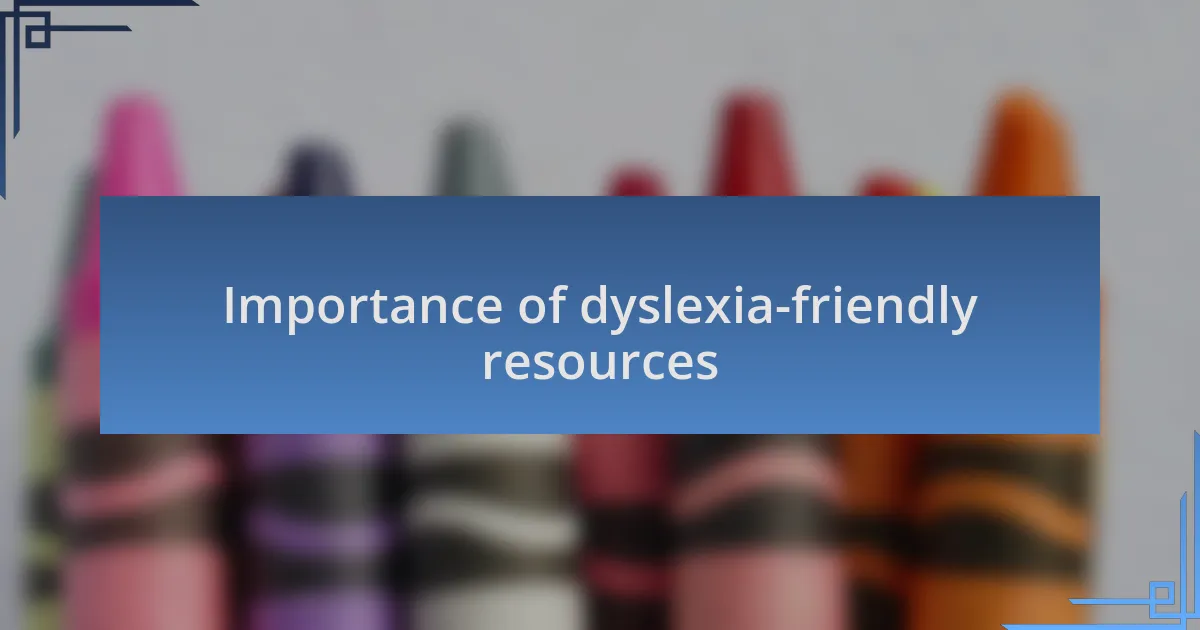
Importance of dyslexia-friendly resources
Dyslexia-friendly resources play a vital role in transforming the learning experience for individuals like me. When I first encountered eBooks designed with dyslexia in mind, I felt a newfound sense of possibility. The fonts, spacing, and color contrasts weren’t just minor tweaks; they made the text approachable instead of daunting. Isn’t it incredible how something as simple as text presentation can empower a learner?
The impact of these resources goes beyond mere readability; they can significantly boost self-esteem. I remember using an interactive dyslexia-friendly eBook and feeling a rush of joy as I navigated through its pages with ease. This sense of accomplishment was a stark contrast to my prior struggles. Can you imagine how different our experiences would be if all reading materials embraced such thoughtful design?
Moreover, having access to dyslexia-friendly resources fosters a supportive learning environment for all. It reminds me of a time in a mixed-ability group where the inclusion of these materials allowed everyone to engage in discussions meaningfully. Instead of feeling like an outsider, I was part of a collaborative effort to learn and grow. How empowering it is when everyone can access the same information in ways that suit their needs!
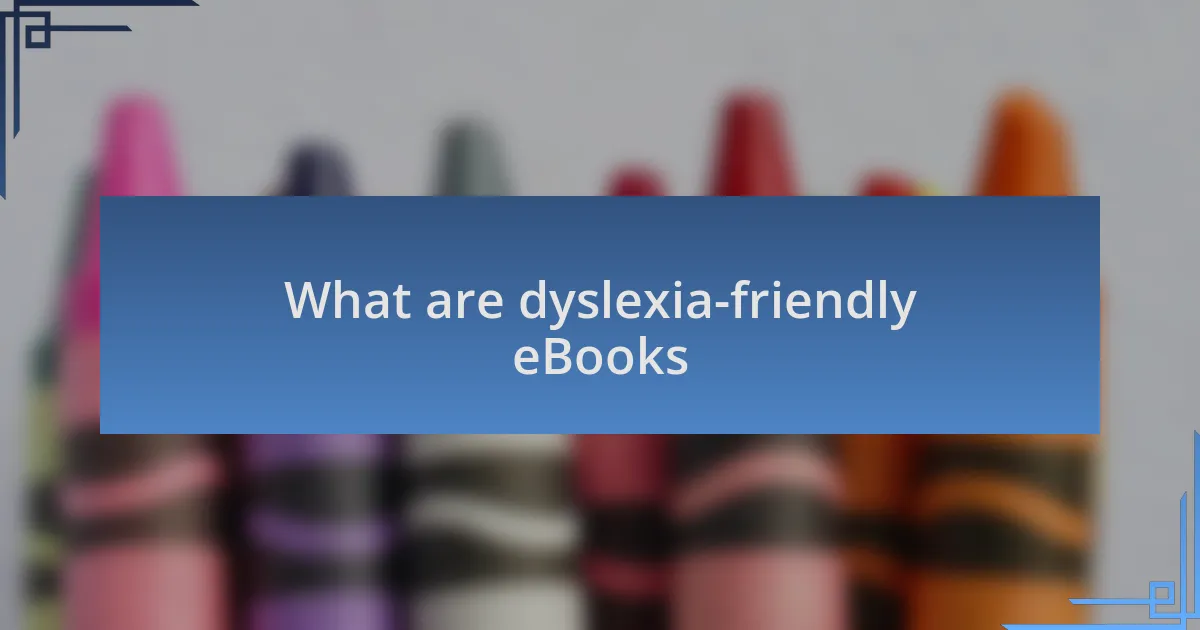
What are dyslexia-friendly eBooks
Dyslexia-friendly eBooks are specially designed digital texts that take into account the unique challenges faced by individuals with dyslexia. I’ve often noticed that features like larger, sans-serif fonts and adjustable line spacing can transform a page that once seemed overwhelming into something inviting. Have you ever felt the relief that comes from being able to read without straining your eyes or losing your place?
These eBooks also incorporate color contrast techniques that enhance readability, making it easier for learners to focus. I vividly recall using a dyslexia-friendly eBook with a warm background color that felt soothing and welcoming. It was a game changer for me, as I could concentrate on the story rather than on the struggles of decoding text. Isn’t it fascinating how a simple design choice can shift our entire learning experience?
Beyond aesthetics, dyslexia-friendly eBooks often include features like read-aloud options and interactive elements. I remember one particular eBook that read each word aloud as I followed along, which made all the difference in my understanding. It felt like having a personal tutor right beside me, guiding me through the text. This aspect not only aids comprehension but also nurturing a love for reading, which I think everyone deserves to experience!
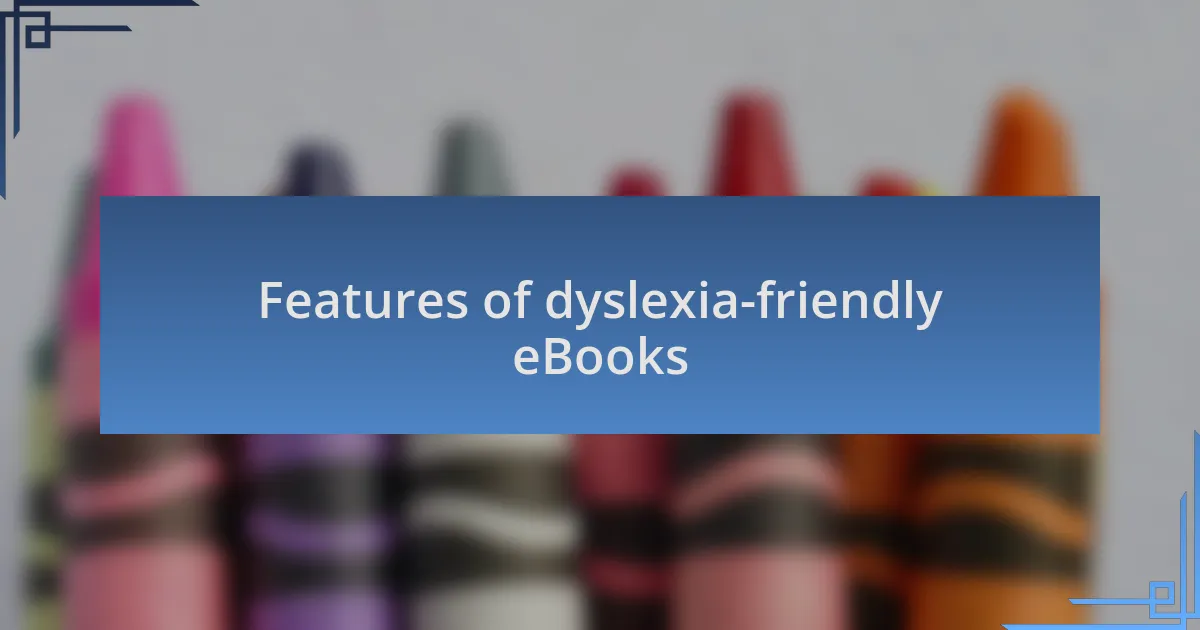
Features of dyslexia-friendly eBooks
When I first encountered dyslexia-friendly eBooks, I was struck by features like customizability. Adjusting the font size and background color to suit my preferences felt empowering. It was as though I finally had control over my reading experience, leading me to wonder how many others might thrive with just a few simple tweaks.
Another standout feature is the structured layout that often breaks text into smaller chunks. I remember feeling overwhelmed when faced with dense paragraphs in traditional books. But with dyslexia-friendly eBooks, the use of bullet points and ample white space allowed me to navigate the content more easily. Have you ever noticed how a little breathing room on the page can make a world of difference?
Moreover, many dyslexia-friendly eBooks include glossaries and definitions embedded within the text. This feature became a revelation for me, especially when I came across unfamiliar terms. Rather than losing momentum while flipping to a dictionary, I could explore the words seamlessly, keeping my flow uninterrupted. Isn’t it amazing how these thoughtful touches can foster both independence and confidence in our reading journeys?
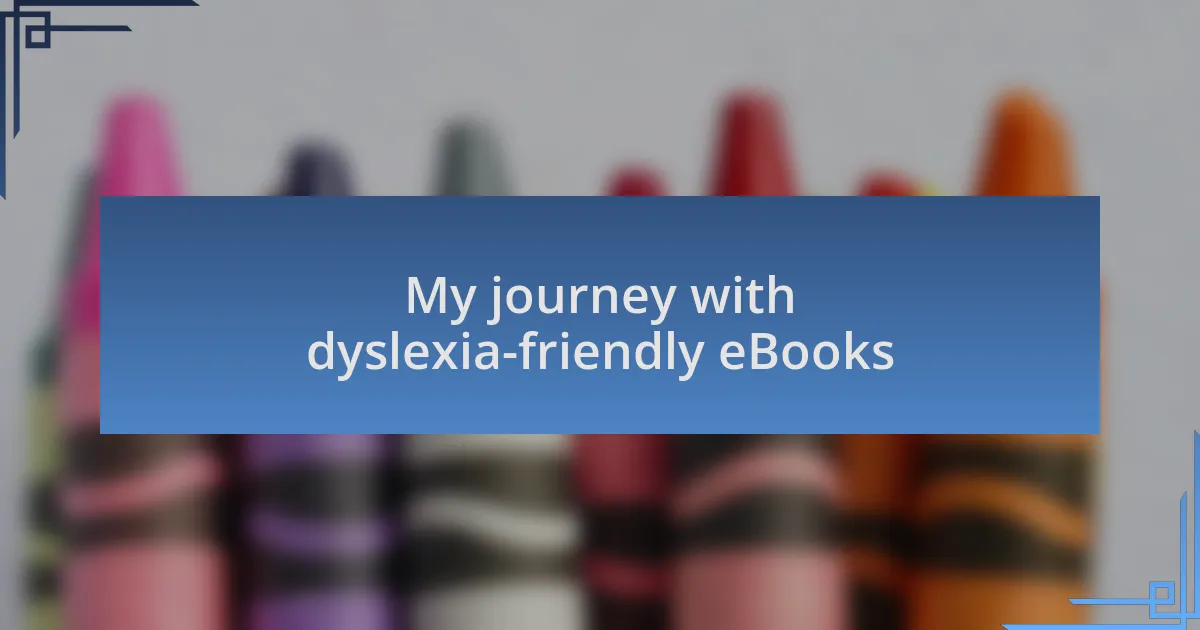
My journey with dyslexia-friendly eBooks
I still remember the first time I downloaded a dyslexia-friendly eBook. As I adjusted the font size to something more comfortable, I felt an unexpected rush of excitement; it was as if I had discovered a new tool that could make reading enjoyable instead of a struggle. Have you ever experienced that moment when you realize something you’ve long endured can actually cater to your needs?
As I delved deeper into these eBooks, I found the interactive elements captivating. The ability to highlight passages or make notes right beside the text transformed my reading sessions into a dialogue with the material. I can vividly recall a time when I was captivated by a story, and rather than losing my thoughts, I could jot them down instantly. It was liberating to engage with the content actively, fostering a more profound connection that I had previously missed.
I also began to notice how the inclusion of audio features greatly enhanced my understanding. Sometimes, when reading alone, I would stumble over words or lose my place, but with the option to hear the text read aloud, I experienced a comforting rhythm that guided me. Have you ever found comfort in hearing a story unfold, combining both sight and sound? In my case, it transformed my perception of reading from a challenge into a journey to be embraced.
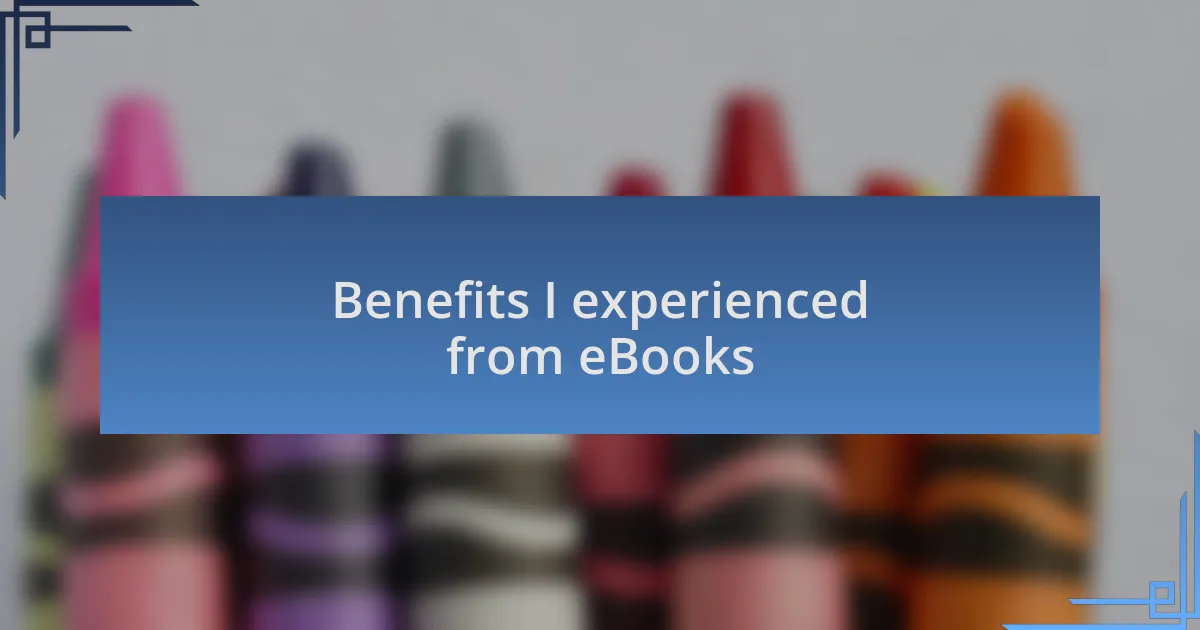
Benefits I experienced from eBooks
One of the most significant benefits I experienced from dyslexia-friendly eBooks was the flexibility they offered in terms of reading speed. I remember my old struggle to keep up with the printed pages often resulted in frustration and fatigue. However, with the adjustable formatting options in eBooks, I could take my time, pausing to absorb the information without the pressure of racing to the end of a page. Isn’t it amazing how such simple adjustments can alleviate stress and make reading more enjoyable?
Additionally, I found that the self-paced nature of eBooks empowered me to tackle more challenging texts. There were times I felt daunted by the size of a book, but with an eBook, I could easily break it down into manageable sections. This sense of control not only boosted my confidence but also encouraged me to explore genres I had previously avoided due to fear of difficulty. Have you ever felt ready to dive into something new, simply because the format made it feel achievable?
Finally, the visual customization features were a game-changer for me. I vividly remember experimenting with different background colors and font styles until I found the perfect combination that minimized distractions and made reading a breeze. That sense of ownership over my reading experience allowed me to engage more deeply with the text. It’s fascinating how a personalized approach can transform a daunting task into an adventure.